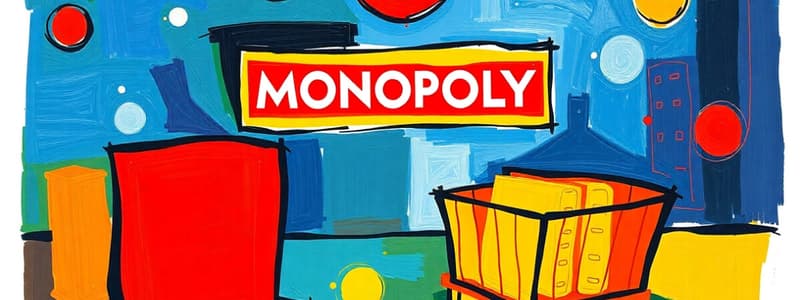Podcast
Questions and Answers
Which scenario would cause Firm A to gain the most from a cartel agreement?
Which scenario would cause Firm A to gain the most from a cartel agreement?
- All firms, except Firm A, cooperate and restrict output. (correct)
- Firm A restricts output, while the other firms do not.
- All firms revert back to their competitive outputs.
- All firms, including A, cooperate and restrict output.
- No firms restrict output.
A cartel can enforce output restrictions effectively and is likely to last long.
A cartel can enforce output restrictions effectively and is likely to last long.
False (B)
What are the three conditions required for price discrimination to be possible?
What are the three conditions required for price discrimination to be possible?
- Firms have market power, 2) Consumers differ in their valuations of the product, 3) Firms can prevent arbitrage.
A monopoly is a market containing ________.
A monopoly is a market containing ________.
What type of demand curve does a monopoly firm face?
What type of demand curve does a monopoly firm face?
For a monopolist, marginal revenue is greater than price.
For a monopolist, marginal revenue is greater than price.
Price discrimination increases firms' profits because it allows them to charge ________ prices to different consumers.
Price discrimination increases firms' profits because it allows them to charge ________ prices to different consumers.
Match the definition with the corresponding economic term.
Match the definition with the corresponding economic term.
What is the total costs for the family-owned firm?
What is the total costs for the family-owned firm?
What are the implicit costs for the family-owned firm?
What are the implicit costs for the family-owned firm?
A firm's economic profit is calculated by subtracting explicit costs from total revenues.
A firm's economic profit is calculated by subtracting explicit costs from total revenues.
What is the primary strategy for a monopolistically competitive firm to maximize its profits in the short run?
What is the primary strategy for a monopolistically competitive firm to maximize its profits in the short run?
Define total product (TP).
Define total product (TP).
Oligopolistic firms will always make more joint profits if they choose to cheat on a cooperative agreement.
Oligopolistic firms will always make more joint profits if they choose to cheat on a cooperative agreement.
The law of diminishing returns states that as more workers are added, each worker's _______ product initially rises.
The law of diminishing returns states that as more workers are added, each worker's _______ product initially rises.
For which of the following is the implicit cost potentially different from the explicit cost?
For which of the following is the implicit cost potentially different from the explicit cost?
What is collusion in the context of oligopoly?
What is collusion in the context of oligopoly?
Match the following concepts with their definitions:
Match the following concepts with their definitions:
The strategic dilemma faced by oligopolistic firms revolves around whether to cooperate or __________.
The strategic dilemma faced by oligopolistic firms revolves around whether to cooperate or __________.
Which of the following can create entry barriers for new firms in an oligopolistic market?
Which of the following can create entry barriers for new firms in an oligopolistic market?
What characterizes the short run in production?
What characterizes the short run in production?
Match the following types of collusion with their definitions:
Match the following types of collusion with their definitions:
Which of the following best describes a differentiated product?
Which of the following best describes a differentiated product?
Firms in perfectly competitive markets are price setters.
Firms in perfectly competitive markets are price setters.
Predatory pricing is a strategy intended to deter new firms from entering a market.
Predatory pricing is a strategy intended to deter new firms from entering a market.
What do firms in monopolistic competition ignore when making pricing decisions?
What do firms in monopolistic competition ignore when making pricing decisions?
In a simplified duopoly scenario, what is the output produced when firms choose to cooperate?
In a simplified duopoly scenario, what is the output produced when firms choose to cooperate?
In monopolistic competition, firms face a ___________ demand curve due to the differentiation of their products.
In monopolistic competition, firms face a ___________ demand curve due to the differentiation of their products.
Match the following market characteristics with their respective market structures:
Match the following market characteristics with their respective market structures:
What is a primary reason firms in imperfectly competitive markets engage in non-price competition?
What is a primary reason firms in imperfectly competitive markets engage in non-price competition?
A firm’s economic profit includes:
A firm’s economic profit includes:
Under monopolistic competition, firms minimize average total costs (ATC) in the long run.
Under monopolistic competition, firms minimize average total costs (ATC) in the long run.
Name three industries commonly associated with monopolistic competition.
Name three industries commonly associated with monopolistic competition.
In the short run, all factors of production are variable.
In the short run, all factors of production are variable.
What is the minimum point of the average total cost (ATC) curve associated with?
What is the minimum point of the average total cost (ATC) curve associated with?
In a perfectly competitive market, firms are __________.
In a perfectly competitive market, firms are __________.
Diminishing marginal returns occur when:
Diminishing marginal returns occur when:
Explicit costs can be calculated by adding __________, __________, and __________.
Explicit costs can be calculated by adding __________, __________, and __________.
Calculate the explicit costs if the total revenue is $500,000 and the wages amount to $200,000, rent to $105,000, and depreciation to $25,000.
Calculate the explicit costs if the total revenue is $500,000 and the wages amount to $200,000, rent to $105,000, and depreciation to $25,000.
The fraction of total market sales controlled by a specified number of the industry’s largest firms is known as ________.
The fraction of total market sales controlled by a specified number of the industry’s largest firms is known as ________.
Advertising is more prevalent in monopolistic competition than it is in a monopoly.
Advertising is more prevalent in monopolistic competition than it is in a monopoly.
What market structure is characterized by many firms, freedom of entry and exit, and somewhat differentiated products?
What market structure is characterized by many firms, freedom of entry and exit, and somewhat differentiated products?
Differentiated products refer to a group of commodities that are similar enough to be called the same product, but dissimilar enough to be ________.
Differentiated products refer to a group of commodities that are similar enough to be called the same product, but dissimilar enough to be ________.
A firm’s ability to raise price without losing all of its sales refers to its ________.
A firm’s ability to raise price without losing all of its sales refers to its ________.
An industry that contains two or more firms, at least one of which produces a significant portion of the industry’s total output, is known as ________.
An industry that contains two or more firms, at least one of which produces a significant portion of the industry’s total output, is known as ________.
What is the theory that studies decision-making in situations where one player anticipates the reaction of other players to its own action?
What is the theory that studies decision-making in situations where one player anticipates the reaction of other players to its own action?
Match the following market structures with their characteristics:
Match the following market structures with their characteristics:
Flashcards
Economic Profit
Economic Profit
Economic profit considers both explicit and implicit costs, representing the difference between total revenue and all costs.
Explicit Costs
Explicit Costs
Explicit costs are the direct payments made to other factors of production, such as wages, rent, or materials.
Implicit Costs
Implicit Costs
Implicit costs are the opportunity costs of using resources that a firm already owns or controls. These include, for example, the owner’s time or lost opportunities
Fixed Input (Short Run)
Fixed Input (Short Run)
Signup and view all the flashcards
Marginal Cost (MC)
Marginal Cost (MC)
Signup and view all the flashcards
Average Total Cost (ATC)
Average Total Cost (ATC)
Signup and view all the flashcards
Perfect Competition (Market Structure)
Perfect Competition (Market Structure)
Signup and view all the flashcards
Diminishing Marginal Returns
Diminishing Marginal Returns
Signup and view all the flashcards
Short Run
Short Run
Signup and view all the flashcards
Long Run
Long Run
Signup and view all the flashcards
Total Product (TP)
Total Product (TP)
Signup and view all the flashcards
Average Product (AP)
Average Product (AP)
Signup and view all the flashcards
Diminishing Marginal Product
Diminishing Marginal Product
Signup and view all the flashcards
Cartel Incentive to Cheat
Cartel Incentive to Cheat
Signup and view all the flashcards
Cartel Sustainability
Cartel Sustainability
Signup and view all the flashcards
Price Discrimination
Price Discrimination
Signup and view all the flashcards
Price Discrimination Conditions
Price Discrimination Conditions
Signup and view all the flashcards
Hurdle Pricing
Hurdle Pricing
Signup and view all the flashcards
Monopoly Structure
Monopoly Structure
Signup and view all the flashcards
Monopoly Demand Curve
Monopoly Demand Curve
Signup and view all the flashcards
Monopoly Marginal Revenue
Monopoly Marginal Revenue
Signup and view all the flashcards
Differentiated Product
Differentiated Product
Signup and view all the flashcards
Imperfect Competition
Imperfect Competition
Signup and view all the flashcards
Monopolistic Competition
Monopolistic Competition
Signup and view all the flashcards
Excess Capacity
Excess Capacity
Signup and view all the flashcards
Price Setter
Price Setter
Signup and view all the flashcards
Non-price Competition
Non-price Competition
Signup and view all the flashcards
Oligopoly
Oligopoly
Signup and view all the flashcards
Concentration Ratio
Concentration Ratio
Signup and view all the flashcards
Why is Advertising More Prevalent in Monopolistic Competition?
Why is Advertising More Prevalent in Monopolistic Competition?
Signup and view all the flashcards
Market Power
Market Power
Signup and view all the flashcards
Game Theory
Game Theory
Signup and view all the flashcards
MES (Minimum Efficient Scale)
MES (Minimum Efficient Scale)
Signup and view all the flashcards
Collusion
Collusion
Signup and view all the flashcards
Tacit Collusion
Tacit Collusion
Signup and view all the flashcards
Entry Barriers
Entry Barriers
Signup and view all the flashcards
Brand Proliferation
Brand Proliferation
Signup and view all the flashcards
Advertising as an Entry Barrier
Advertising as an Entry Barrier
Signup and view all the flashcards
Predatory Pricing
Predatory Pricing
Signup and view all the flashcards
Study Notes
Microeconomics Study Notes
- Microeconomics is the study of individual economic agents such as households and firms.
- It analyses how these agents make decisions in markets.
- It examines how different market structures affect firms' behaviors and product prices.
Firm's Costs and Profits
- Explicit costs are the direct monetary payments a firm makes for inputs (e.g. wages, rent).
- Implicit costs are the opportunity costs of using resources that the firm already owns (e.g., owner's forgone salary).
- Economic profit considers both explicit and implicit costs, while accounting profit only considers explicit costs.
Short-Run Costs
- Total cost (TC): the sum of fixed and variable costs.
- Fixed cost (FC): costs that do not vary with output in the short run (e.g., rent).
- Variable cost (VC): costs that vary with output in the short run (e.g., labor costs).
- Average total cost (ATC): total cost divided by output.
- Average fixed cost (AFC): fixed cost divided by output.
- Average variable cost (AVC): variable cost divided by output.
- Marginal cost (MC): the change in total cost from producing one more unit of output.
Long-Run Costs
- All inputs are variable in the long run.
- Firms can adjust to various levels of output in the long run.
- The long-run average cost (LRAC), curve shows the lowest cost at which a firm can produce any output level.
- The LRAC curve is usually U-shaped.
- Increasing returns to scale, constant returns to scale, and decreasing returns to scale explain the shape of the LRAC curve.
Market Structures
- Perfect competition: many firms, identical products, free entry/exit. Firms are price takers (take prevailing market price).
- Monopoly: one firm, no close substitutes, significant barriers to entry. Firms are price setters (set their own price).
- Monopolistic competition: many firms, differentiated products, relatively easy entry/exit. Firms are price setters (but not as much as in monopoly).
- Oligopoly: a few firms, significant strategic interaction, substantial barriers to entry. All firms must consider how their decisions affect others.
Short-Run Profit Maximization
- In perfect competition, produce where price equals marginal cost (P = MC).
- In monopoly, produce where marginal revenue equals marginal cost (MR = MC).
- In monopolistic competition and oligopoly, equate marginal revenue (MR) to marginal cost (MC).
- Firms will keep operating as long as price exceeds average variable cost (P > AVC). If price falls below this level, firms shut down to minimize losses.
- Firms in general will produce where marginal revenue equals marginal cost (MC = MR).
Long-Run Profit Maximization
- In perfect competition, firms will operate at the minimum average total cost (ATC) and earn normal profits.
- In monopoly and monopolistic competition, firms may earn economic profits. The existence of economic profits drives new firms into the market. This reduces the market price and eventually eliminates economic profit.
- Firms in general will produce where price equals average total cost (P=ATC) in the long run to have zero economic profit.
Price Discrimination
- Firms practicing price discrimination can sell goods or services at different prices to different consumer segments. Often done to extract surplus.
Cartels
- Cartels are groups of firms who come together and agree to act like a monopoly in order to gain higher profit.
- They can raise prices and reduce output.
- These cartels are susceptible to member firms' incentives to cheat and undercut the group output agreement. This often leads to the cartel's dissolution.
Studying That Suits You
Use AI to generate personalized quizzes and flashcards to suit your learning preferences.
Related Documents
Description
Test your understanding of key concepts in microeconomics, focusing on monopolies, oligopolies, and price discrimination. Explore scenarios involving cartel agreements and calculate economic profits for family-owned firms. This quiz is ideal for students studying microeconomic theory.




